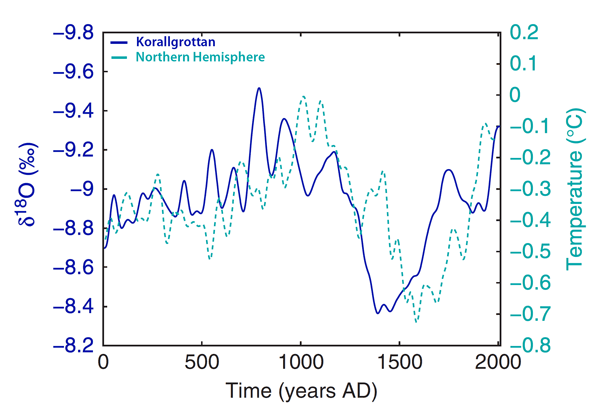Reference
Sundqvist, H.S., Holmgren, K., Moberg, A., Spotl, C. and Mangini, A. 2010. Stable isotopes in a stalagmite from NW Sweden document environmental changes over the past 4000 years. Boreas 39: 77-86.
Other Reference
Moberg, A., Sonechkin, D.M., Holmgren, K., Datsenko, N.M. and Karlen, W. 2005. Highly variable Northern Hemisphere temperatures reconstructed from low- and high-resolution proxy data. Nature 433: 613-617.
Description
Working with a stalagmite (K11) that they collected in 2005 from Korallgrottan -- a cave in the Caledonian mountain range of Jamtland County, northwest Sweden (64°53'N, 14°E) -- Sundqvist et al. developed a 4000-year δ18O history, which they demonstrated to be well correlated with temperature, even that of the entire Northern Hemisphere, in fact, as may be seen in the figure below.

Figure 1. The 2000-year Northern Hemispheric temperature reconstruction (dashed line) of Moberg et al. (2005) and the last half of the δ18O history (solid line) developed from the K11 stalagmite. Adapted from Sundqvist et al. (2010).
In describing the δ18O history, Sundqvist et al. write that "the stable isotope records show enriched isotopic values during the, for Scandinavia, comparatively cold period AD 1300-1700 [which they equate with the Little Ice Age] and depleted values during the warmer period AD 800-1000 [which they equate with the Medieval Warm Period]." And as can clearly be seen from the figure above, the two δ18O depletion "peaks" (actually inverted valleys) of the Medieval Warm Period are both more extreme than the "peak" value of the Current Warm Period, which appears at the end of the record.




